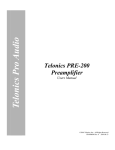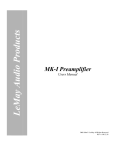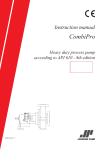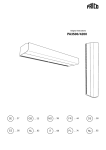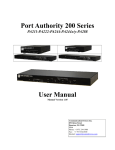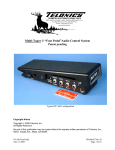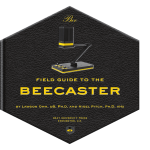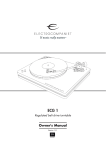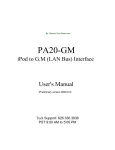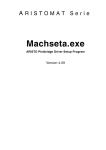Download here. - Telonics Pro Audio
Transcript
Telonics Pro Audio Telonics PRE-1000 Preamplifier Users Manual ©2010 Telonics, Inc. All Rights Reserved PB-00xxxx Rev 2010.11.17 The Telonics PRE-1000 Congratulations on purchasing one of the world’s finest professional instrument preamplifiers! The PRE-1000 preamplifier is a state of the art audiophile quality unit designed and built with the best sounding technology. The PRE-1000 preamplifier gives you dramatically better control of your sound. The result is transparent smooth clean sound, tight bottom end and silky highs. It’s just what you’ve been looking for! Telonics PRE-1000 Preamp Features: • Superb string separation at all volume levels. No muddiness! • All pure analog. No digitization of your sound thru A/D or D/A converters. • Has Pre EQ Insert Send and Return. (Rear panel mounted). • Adjustable input impedance control to fine tune your sound. • Warm tube-like sound with crystal clear highs. • Ultra low noise – studio quality. • High headroom. • High output level available on demand. • Studio style parallel effects with adjustable send and return levels. Can be used in stereo or mono. • Built in electronic reverb on both channels with common front panel level control. • Overload LED indicator. • New master Wet/Dry fader control. • New switchable “Bro”effect and Hum reduction circuits. • New Pedal Switch on rear panel. Allows switching “Bro” and Reverb. • Special “Blend” EQ control for personalizing your tone. • Special Power On/Off circuit to minimize “pops” and speaker damage. Telonics PRE-1000 Preamplifier PB-00xxxx Rev 2 TELONICS PRE-1000 PREAMP FEATURES: CONTINUED • Built in high output headphone amp with separate volume control. • Super quiet Mute circuit with LED indicator. • Two balanced XLR Direct outputs (Left and Right) for stage and studio use. Includes ground lift switch. • Analog modeling for Direct outs. (3-position switch, Off, Norm, and Mellow) • Buffered tuner output. Remains active when mute is on. • Input jacks located both front and rear. Use only one or the other (the front panel jack auto-disconnects the rear). • Auxiliary stereo inputs for home practice or solo gigs with front panel level control. For CD players or a second effect return. Jacks located both front and rear. • Only requires 1U rack space. • Durable construction throughout. Made for years of trouble free use. • Proudly made in the U.S.A. by musicians and engineers. Telonics PRE-1000 Preamplifier PB-00xxxx Rev 3 PRE-1000 PREAMP CONTROL FUNCTIONS, JACKS, & INDICATORS: FRONT PANEL Input 1 Impedance Adjust for best tone. If a Telonics (buffered) pedal is used before the preamp, set fully clockwise. If the guitar is plugged directly into the preamp, set to taste (5 to 8 for normal tone). Adjustment range is 20 k ohms to 500 k ohms. See FAQ’s Preamp In 1 The primary input 1 has two input connectors (front and rear). Insertion of a plug into the front panel input connector auto-disconnects rear input connector. This reduces or eliminates possible noise sources. Preamp In 2 Secondary input (front panel only) for additional guitar with independent tone controls. Output to a volume pedal. This signal is affected by the input gain control, and is prior to the equalization. Return from volume pedal and is prior to the Pre-EQ Insert on the rear panel. Sets the gain for the first audio stage of Input 1. Start at 3 or 4 and adjust as needed. This gain control affects the level for the Pedal To connector (front panel) which then also affects the Pre-EQ Insert Send connector (rear panel). Sets the gain for the first audio stage of Input 2. Red LED indicator only turns on in a rare instance when peaks are hit. Indication of soft clipping may occur, but you’ll probably never hear it. This LED indicates an overload on the input or equalizer circuits for Input 1 and Input 2. Reduce gain or adjust EQ of active input to eliminate. Pedal To Pedal From Input Gain 1 Input Gain 2 Input/EQ Overload Telonics PRE-1000 Preamplifier PB-00xxxx Rev 4 PRE-1000 PREAMP CONTROL FUNCTIONS, JACKS, & INDICATORS: FRONT PANEL (CONTINUED) Input 1 Tone Bass Level Controls low frequency response. Start at 0 (flat) and adjust to taste. CW is boost, CCW is cut. Level is adjustable from -16 dB cut to +16 dB boost. Input 1 Tone Mid Level Sets a boost or cut in the mid range frequencies selected by the Mid Frequency control. Level is adjustable from -20 dB cut to +5 dB boost. Input 1 Tone Mid Frequency Sets the frequency at which the Mid Level control has an effect. Several frequency intervals between 250 Hz and 1000 Hz are marked. Input 1 Tone Treble Level Adjusts the high frequency level. Clockwise (CW) boosts the level of highs, counterclockwise (CCW) cuts the level of highs. The level is adjustable from -16 dB cut to +16 dB boost. Start at 0 (flat) and adjust to taste. Input 1 Tone Presence Increases the high frequencies up to 9 dB and increases the rate of increase in high frequencies. Start at 5 and set to taste. Input 1 Tone Blend Only set this control after you have set the others. This is to be used as a sonic “shading” control and, like any seasoning, a little goes a long way. Start at 12 o’clock. CW yields a “Mooney” bright aggressive sound; CCW gives you a mellow, darker tone. Input 2 Tone Bass Level Controls low frequency response. Start at 0 (flat) and adjust to taste. CW is boost, CCW is cut. Level is adjustable from about -16 dB cut to +16 dB boost. Adjusts the high frequency level. Clockwise (CW) boosts the level of highs, counterclockwise (CCW) cuts the level of highs. The level is adjustable from -18 dB cut to +24 dB boost. Start at 0 (flat) and adjust to taste. As you increase the treble level (0-+24dB), a presence effect will start to be heard at about +18dB. Input 2 Tone Treble Presence Telonics PRE-1000 Preamplifier PB-00xxxx Rev 5 PRE-1000 PREAMP CONTROL FUNCTIONS, JACKS, & INDICATORS: FRONT PANEL (CONTINUED) BRO HUM Reverb Level WET/DRY Fader Reverb On AUX / Stereo INPUT This switch will activate a “Bro” type effect. The LED will light when Bro is active. The Foot Switch connector on the rear panel will turn Bro off and on if the BRO switch is pushed on (in). If either switch is in the off position, the effect will be off. When the foot switch is not used, the default is on. (See back panel Foot Switch) The HUM switch will activate a hum reduction circuit to minimize hum from single coil pickups. The HUM circuit will reduce 60 Hz hum about 20dB. The LED will light when hum eliminator circuit is active. This level controls how much of the internal reverb signal is applied to the Wet/Dry Fader control. The input level to the reverb circuit is affected by the Input Gain control level. The reverb input is a combination of the dry input after the Tone controls and the Post EQ EFX Return signal (rear panel). This fader controls the amount of wet or dry signal sent to the Master Level control. Full counter clockwise is dry, full clockwise is wet. This LED indicates if the Foot Switch has disabled the reverb. When the LED is on, the internal reverb is active and controlled by the Reverb Level control. When the LED is off, the Foot Switch has disabled the reverb signal. With no foot switch, the default is on. Use a ¼ inch stereo plug to inject audio from a CD or MP3 player for home practice or live gigs. There are two stereo input connectors. Insertion of a plug into the front panel input connector auto-disconnects rear input connector. Use the Aux level control to set music level. Can also be used as a second effects return. Telonics PRE-1000 Preamplifier PB-00xxxx Rev 6 PRE-1000 PREAMP CONTROL FUNCTIONS, JACKS, & INDICATORS: FRONT PANEL (CONTINUED) Master Level Sets the overall output level of the preamp. Typically used between 5 and 8. Headphone Gain Adjusts headphone output level. Turn down when not in use. Headphone Jack 1/4" stereo jack for headphones. This unit puts out up to half a watt per channel into 8 ohms – more than enough for any player at home. We recommend quality headphones such as Sony MDR 7505. Tuner Out Buffered output so it will not load down the pickup or the rest of the signal chain, nor will it allow noise from the tuner to get back into the system. May be used simultaneously with the Tuner Out jack on the rear panel. Output impedance is approximately 500 ohms. Mute Yellow LED comes on when muted. Tuner, Effects and Headphones remain on to allow for string replacement, practice licks, tuning, and effects adjustment. Main Outs and XLR feeds are disabled in mute mode. Turns the unit on and off and is indicated by a blue LED. A time delay is built into the audio circuits to minimize “pop” when turning on or off. Power Telonics PRE-1000 Preamplifier PB-00xxxx Rev 7 PRE-1000 PREAMP CONTROL FUNCTIONS, JACKS, & INDICATORS: REAR PANEL 24 VDC Power input. Use only the factory supplied power supply or power from companion PA-4100/PA100 or PA4200/PA-200 power amplifiers! European voltage version of the power supply is available at a slight added cost. Foot Switch Used to control the Bro and internal Reverb effects. A ¼ inch TRS (tip, ring, and sleeve) plug is needed. The sleeve is common, tip is Bro and ring is reverb. The switch will enable the effects in the closed position. Tuner Out Same function as Tuner Out on front panel. Use for internal feed to rack mounted tuner. Both Tuner Outs may be used simultaneously. Can also be used as a second effects send. The output impedance is approximately 500 ohms. Main Out L (mono), R Use to feed power amp input. Use left output for mono feed. The output impedance is approximately 100 ohms. Outputs have effects return mixed in. See the section “Built In Automatic Stereo or Mono Switching” on page 14 for more information. Telonics PRE-1000 Preamplifier PB-00xxxx Rev 8 PRE-1000 PREAMP CONTROL FUNCTIONS, JACKS, & INDICATORS: REAR PANEL (CONTINUED) Direct Out Amp Modeling Switch This switch allows you to select different amp modeling responses. Off is no modeling. Norm is a normal frequency response from a speaker system. Mellow is a frequency response with little less high frequency in the response. Direct Out Level This level adjustment will allow you to match the signal you are sending to the level required by the mixer or recording device. Most line level devices are either +4dB or -10dB. You can adjust for either, and also adjust low enough for microphone inputs with below -30dB adjustment. Direct Out Left/Right XLR Buffered post effects, post EQ signal for studio or stage use. Output impedance = 600 ohms. Each XLR connector is wired to the standards for audio. Pin 1 is shield, Pin 2 is signal plus, and Pin 3 is signal minus. Individual connectors for Left and Right channels allow for optimum stereo recording. Direct Out GND Lift Telonics PRE-1000 Preamplifier PB-00xxxx Rev This switch allows you to disconnect Pin 1 of the XLR connector from the chassis ground. It is seldom necessary in properly built equipment, but might be needed sometime. Leave in the Norm position unless needed. 9 PRE-1000 PREAMP CONTROL FUNCTIONS, JACKS, & INDICATORS: REAR PANEL (CONTINUED) Post EQ EFX Send Level This adjusts the level to your effects unit. This will allow you to have enough of a signal to make the effects work well and yet not overdrive it. EFX Send Mono send to parallel mode effects unit input. Use a ¼ inch TS (tip, sleeve) phone plug. Note: this is an Input 1 post EQ signal only. Post EQ EFX From – L (Mono) Return from left channel of effects unit (or use as mono only return). Post EQ EFX From – R Return from right channel of effects unit (if present). EFX Return Level This switch allow you to select the nominal signal level coming from your effects unit, either +4dB (switch out) or -10dB (switch in). Most “Pro” equipment is usually +4dB while consumer equipment is usually -10dB. Telonics PRE-1000 Preamplifier PB-00xxxx Rev 10 PRE-1000 PREAMP CONTROL FUNCTIONS, JACKS, & INDICATORS: REAR PANEL (CONTINUED) Pre EQ Insert Send Pre EQ Insert Return Preamp In Aux Input (stereo) This insert send follows the Input 1 Gain control and the Pedal loop on the front panel. This signal is affected by the Input 1 Gain level and the result of any Pedal loop control. This insert return is prior to all of the effects and equalization circuits. This includes Bro, Hum, Reverb, Wet/Dry fader, and all of the Input 1 Tone controls. Same function as the Preamp Input 1 connector on front panel. Front panel connector takes precedence over rear panel connector. Insertion of a plug into the front panel connector auto-disconnects this rear input connector. This reduces or eliminates possible noise sources. Use a ¼ inch stereo plug to inject audio from a CD or MP3 player for home practice or live gigs. There are two stereo input connectors. Insertion of a plug into the front panel input connector auto-disconnects rear input connector. Use the Aux (stereo) Level control to set music level. Can also be used as a second effects return. If used as second effects return, the rear tuner out can be used as effects send. See FAQ sheet. Telonics PRE-1000 Preamplifier PB-00xxxx Rev 11 FREQUENTLY ASKED QUESTIONS How and when do I use the Input Impedance control? The input impedance control is used only when a direct connection from the pickup on your instrument to the preamp input is desired (“3-wire hook up”). The volume pedal is then placed in the PRE EQ EFX To/From (insert) on the rear panel for low noise control of the instrument volume. NOTE: Always set to maximum (fully rotated clockwise) if you choose NOT to use the PRE EQ EFX To/From feature (“3-wire hook up”). This ensures the input will maintain proper high frequency response. To adjust the impedance control properly, start with the impedance control fully clockwise, and then adjust all the preamp tone controls for the best sound. Only after adjusting the controls to taste should you make slight adjustments to the impedance control. Rotating it fully counterclockwise will equal approximately 20 000 ohms (20 k ohms), which is equal to the impedance of many conventional inexpensive pedals made for guitars. This is almost always too low for steel guitars. Setting the input impedance control to the twelve o’clock position makes the input impedance approximately 150 000 ohms (150 k ohms), which is equivalent to the most popular or generally accepted setting for steel and jazz guitar electronic or “light style” pedals. A setting of full clockwise will approximate the old AB pot pedals which were 500 000 ohms (500 k ohms). Some musicians who have played for many years find their high frequency hearing response has degraded. Musicians under these circumstances may feel this control does not appear to do much or anything. In this case, it is recommended to just leave it set between positions 5 and 8 for the benefit of your listeners. What’s a good setting to start with on the Preamp Gain control? Between “4” and “6” is a good starting point. The Input Gain control delivers plenty of level so be cautious in its use. What are the frequencies covered by the Mid Freq control? Mid Level? The “Mid Freq” control has a range from 250 Hz to about 1100 Hz. The range is scaled to values of, 250, 275, 300, 350, 400, 500, 600, 800 and 1000 Hz. The “Mid Level” control adjusts from -16 dB cut at full CCW position to a +16 dB boost at full CW position. What does the Blend control do? This control is used as an overall tone control to be used only after setting the other tone controls to your satisfaction. Rotating the knob clockwise yields a brighter more aggressive tone and counterclockwise results in a mellower, warmer tone. Straight up (zero) yields no change. What’s a good setting to start with on the Master Level control? Five is a good place to start. The Master Level control delivers plenty of level so be cautious in its use. Telonics PRE-1000 Preamplifier PB-00xxxx Rev 12 FREQUENTLY ASKED QUESTIONS (CONTINUED) What kind of headphones should I use? Use low impedance (35-60 ohms) stereo closed or open style depending on personal preference. Sony MDR 7505 headphones are recommended for best fidelity. Can I drive speakers with the headphone jack? It was designed for headphones. The preamp will deliver up to half a watt per channel into eight ohms from its internal stereo headphone amp. What does the red LED indicator show? The Overload LED shows when the preamp enters soft clipping. Although you might see it light up on rare occasions, you’ll probably never hear the difference. This LED indicates an overload on the input or equalizer circuits for Input 1 and Input 2. Reduce gain or adjust EQ of active input to eliminate. Tell me about the Tuner Out function. The Tuner Out jacks have a buffer stage and circuitry which isolates both outputs of the tuner from the rest of the circuitry eliminating a common source of noise. This circuit will not load down the pickup or any preamp stage. The front and rear panel jacks can be used at the same time. The Tuner Out can also be used as an effects send. What does the Mute button do? When engaged, the mute function allows the tuner, headphone amp, and effects send and return to remain on while the power amp send and XLR direct out feed are disabled. This way you can practice at home or in between songs on stage without your power amp on and still get a stereo feed to your headphones complete with stereo effects. Use it to mute your output while changing a string, tuning up or adjusting the effects unit. Will pushing the Mute button send a loud “pop” into my speakers, headphones or the XLR Direct Out (the house feed) when I activate it? No, the preamp employs silent muting circuitry. How do I use the Aux In feature? The Aux In may be used to input stereo rhythm tracks or background music from CD or MP3 players. The Aux In feature can also function like a second stereo effects return. It can be used as a way to inject practice music into the main channels and/or headphones or to add a second effects return. The amount of music or effects level is determined by the output level of the music or effects player and the Aux In Level control. Can I safely run phantom power into my Direct Out circuit? While it is not necessary (nor a good idea) to run phantom voltage into the Direct Out connector, it is designed to withstand the IEC specified maximum of 10 milliamps without damage. What output level can I expect to see from the Direct Output connector? The output is approximately the same as the main outputs, up to 5 volts maximum. Telonics PRE-1000 Preamplifier PB-00xxxx Rev 13 BASIC HOOKUP DIAGRAM NOTE: Aux In L & R are on a 1/4 in TRS jack: Tip is Left, Ring is Right, Sleeve is Ground BUILT IN AUTOMATIC STEREO OR MONO OUTPUT SWITCHING The PRE-1000 incorporates a feature which automatically ensures that its internal stereo/monaural signal routing is correct by sensing which output connectors are connected to an external power amplifier. If only the Left (mono) output jack is used, the PRE-1000 mixes all EFX and AUX stereo signals to mono ensuring that all program material will be heard through the mono amplifier. If both the Left and Right output jacks are employed, the PRE-1000 routes EFX and AUX stereo signals appropriately, ensuring that they will be amplified as stereo, by the two power amplifier channels and the headphones. Telonics PRE-1000 Preamplifier PB-00xxxx Rev 14 MECHANICAL DATA Chassis Material Aluminum Finish Hard Anodized Front & Rear Panel Markings Laser Etched Panel Meets industry standard specifications (EIA-310-D, CEA-310-E, IEC 60297-3-100, and DIN 41494-7). Panel Thickness 0.25 in. (0.63 cm) Panel Height 1.70 in.(4.32 cm) typical 1.75 in. (4.45 cm) max Panel Width 19.0 in. (48.3 cm) max Internal chassis/cabinet width (including screws) 17.32 in. (44 cm) Internal chassis/cabinet height 1.73 in (4.39 cm) typical 1.75 in. (4.45 cm) max Internal chassis/cabinet depth 5.25 in. (13.3 cm) Total protrusion of jacks beyond rear chassis (max) 0.235 in. (0.597 cm) Total protrusion of knobs beyond front panel 0.72 in. (1.83 cm) max Total weight 2.95 lb. (1.338 kg) ELECTRICAL DATA Input Voltage 24VDC center pin is positive. Input Power 15 Watts maximum. Approved Power sources 115VAC to 24VDC wall wart supplied, International 100VAC-240VAC to 24VDC wall warts available, Telonics PA-4100/PA-100 mono power amp, and Telonics PA-4200/PA-200 stereo power amp System Audio Gain 48 dB Telonics PRE-1000 Preamplifier PB-00xxxx Rev 15















